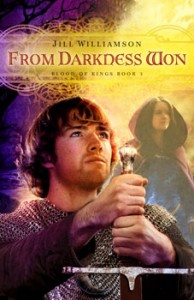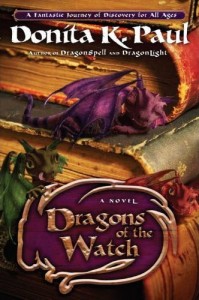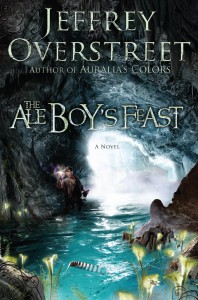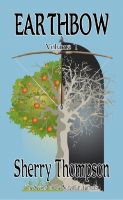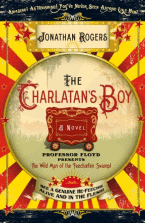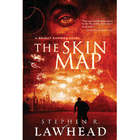 The Skin Map by Stephen Lawhead
The Skin Map by Stephen Lawhead
Published 2010 by Thomas Nelson, 398 pages
Genre: Fantasy, suitable for adults and teens
Stephen Lawhead starts off his new Bright Empires series with this book, The Skin Map. The title refers to a grisly artifact: a parchment made from the skin of a man. This man was an experienced time/space traveler across alternate universes who had his torso tatooed with markings that served as a map in case he would get lost. (I was put off by the grisly part, but decided to forge ahead anyway, and I am very glad I did. There was nothing gory about this book.)
An alternate universe, by the way, is spawned by decisions made differently at a key point in history. For example, two of the characters go back to 1600s London and purposefully wake someone up so as to prevent the Great Fire of London. So from that point on, history is different in that universe.
The alternate universes idea is a favorite of physicist Stephen Hawkings, and it has made its way into literature before, most notably in Philip Pullman’s The Golden Compass and following books. Pullman argues that God is either dead or irrelevant, so I, a Christian, found reading those books the opposite of edifying. Lawhead, on the other hand, is a Christian, though his books these days are subtle about their underlying worldview. I did enjoy reading this book.
Many fantasy books start with the protagonist living a humdrum existence. Then the protagonist finds himself swept into an alternate fantasy world somehow. In The Skin Map, the main characters find themselves swept not into a fantasy universe, but into medieval Europe in the early 1600s.
Kit Livingstone is a young contemporary Londoner leading a boring life, trying to please a boring girlfriend, when he suddenly meets his great-grandfather in an alley. His great-grandfather, a stranger who is a vigorous old man, invites Kit for a bite to eat and leads him to the other end of the alley–which opens into a medieval fishing village elsewhere in England.
Kit is shocked by the strangeness of the experience and runs back to his humdrum circumstances. He tries to tell his girlfriend about it. She doesn’t believe him, so he brings her to the alley, which runs along a “ley line” or joint line between alternate universes. The ley line returns him to his grandfather’s fishing village, but the girlfriend, Wilhelmina, vanishes into somewhere else. So now Kit and and his great-grandfather have to rescue her–she could be in deep trouble somewhere. But where? And when?
Kit also finds himself enmeshed in his great-grandfather’s struggle against the bad guy, Lord Burleigh, who is crossing time, space, and alternate universes looking for the Skin Map. The great-grandfather has part of the map squirreled away in Oxford, or thinks he does. So Burleigh’s men, armed with a huge saber-toothed cat from the Pleistocene, attack him whenever he uses ley travel.
Meanwhile Wilhelmina finds herself dumped into Prague in the early 1600s. A baker, she is picked up on the roadside by a German baker. Together they start a bakery business. Soon Wilhelmina is actually doing well. She even runs into Lord Burleigh and gets by unscathed.
But things are not going so well for Kit and his great-grandfather in modern Egypt. Together with some allies, they seem to face certain defeat and death at the hands of the evil Burleigh. I will stop here–read the book to find out more!
What do I think?
Lawhead does a great job with his characters. I especially like how Wilhelmina transforms from a catatonic city dweller to an energetic and enterprising businesswoman. Kit grows too, of course. It’s funny when he, a thoroughly modern guy, tries to make friends with a wagon driver from medieval England, who is in a lower social class and gets very uncomfortable.
The story is told through the eyes of four different characters: Kit; Wilhelmina; Arthur, the man with the skin map; and Lord Burleigh. Only a bit is told of Arthur and Lord Burleigh. The sole chapter from Lord Burleigh’s point of view informs us that he is a shady antiquities dealer from the present era, leaving much untold about his motives and designs. But in later chapters it becomes clear that the atheist Burleigh is after information on the mysterious Well of Souls, which may have something to do with reviving the dead. I am wondering now whether there will be an Indiana Jones-like collision of stupid atheists and the raw power of God at the crux of the series, which will run to five books.
Because The Skin Map is part of a larger story, it leaves many issues unresolved. So finishing it is not entirely satisfying. But I am expecting more great characters, plot thickening, and resolution in the next book, and I hope it’s not too long coming out! Lawhead does a great job of spinning a yarn. I recommend this book for teens and adults.
Read my reviews of all five books in the series: one, two, three, four, five.
This review is part of the Christian Science Fiction/Fantasy (CSFF) Blog tour. Take a minute to check out what other bloggers are saying about this book:
Red Bissell
Thomas Clayton Booher
Keanan Brand
Grace Bridges
Beckie Burnham
Morgan L. Busse
Jeff Chapman
Christian Fiction Book Reviews
Valerie Comer
Karri Compton
Amy Cruson
CSFF Blog Tour
Stacey Dale
D. G. D. Davidson
George Duncan
April Erwin
Tori Greene
Ryan Heart
Bruce Hennigan
Timothy Hicks
Christopher Hopper
Becky Jesse
Cris Jesse
Becca Johnson
Jason Joyner
Julie
Carol Keen
Krystine Kercher
Shannon McDermott
Allen McGraw
Matt Mikalatos
Rebecca LuElla Miller
Nissa
John W. Otte
Gavin Patchett
Sarah Sawyer
Chawna Schroeder
Kathleen Smith
Rachel Starr Thomson
Donna Swanson
Robert Treskillard
Steve Trower
Fred Warren
Dona Watson
Phyllis Wheeler
Nicole White
Elizabeth Williams
Dave Wilson
Author’s website:
http://www.stephenlawhead.com/

